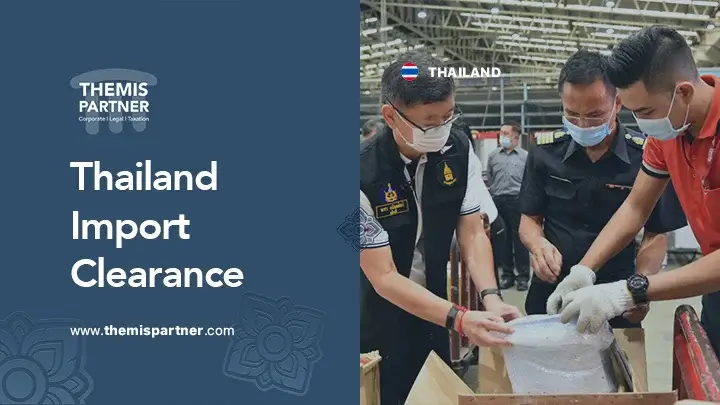Miss just one digital document in Thailand Import Clearance Procedures and your shipment can be flagged for immediate hold or costly fines: as of 2025, Thailand customs clearance is 100% paperless and moves at digital speed.
Are your digital declarations ready to pass strict new customs checks before your goods even land at port?

Thailand’s import regulations are changing fast for business owners and professionals: mandatory e-filings through the National Single Window eliminate paperwork bottlenecks, but every step now demands pinpoint accuracy.
Key Takeaways
- Thailand’s import clearance is fully digital in 2025: Submit all documents online via the National Single Window (NSW) and e-Customs, as physical paperwork is not accepted.
- Register on the NSW portal before goods arrive to prevent delays; late or incomplete digital uploads trigger fines, shipment holds, or revocation of importer status.
- Compliance accuracy is essential: Mismatched product data, HS codes, or permit numbers across digital forms can result in immediate penalties up to 100% of shipment value, plus detailed customs inspections.
- Key documents must be submitted digitally: Prepare a commercial invoice, packing list, bill of lading, certificate of origin, insurance policy, and digital permits, ensuring all details precisely match customs declarations.
- Customs risk assessment assigns your shipment to Green Line or Red Line: Over 85% of compliant shipments are released automatically, while small data errors instantly trigger time-consuming inspections.
- Import duties, VAT (7%), and fees are calculated on CIF value: Use the correct HS code and valid certificates of origin for tariff reductions; incorrect calculations cause costly holdups.
- Work with licensed customs brokers for complex shipments: A certified broker with NSW digital expertise can cut processing times by up to 40% and help avoid common compliance errors.
- Stay updated on Thailand’s restricted and prohibited items: Plastic waste, 463 e-waste types, and hazardous goods are fully banned in 2025, requiring regular review of official customs lists and prompt digital permit linkage.
Thailand Import Clearance 2025
Digital Clearance System Explained
Thailand’s 2025 import clearance is now 100 percent digital: all declarations and documents are submitted via the National Single Window (NSW) and e-Customs platform.
To start:
- Register as an importer on the NSW portal, uploading your company and ID documents.
- Prepare and submit digital-only documents, including commercial invoices, packing lists, and certificates of origin.
- Monitor compliance milestones with automated status alerts and digital tracking.
Key dates: Digital submission is mandatory before goods arrive. Incomplete or late uploads result in shipment holds or fines.
This system speeds up clearance, cuts paperwork, and reduces errors, saving importers both time and costs. The NSW’s streamlined interface and built-in validation tools are essential for passing risk assessment quickly.
See the Thai Customs Department portal for current workflows.
Key Import Rules & Requirements
Thai import law in 2025 features updated rules on banned goods: plastic waste, 463 e-waste types, and certain hazardous items are absolutely prohibited.
Oversight agencies include:
- Customs Department (HS code and value verification)
- FDA (health, cosmetics, hazardous substances)
- Ministry of Commerce (strategic and restricted goods)
Non-compliance such as submitting incorrect product data or importing regulated goods without proper permits results in penalties of up to 100% of the shipment’s value, fines, and possible suspension of importer status.
Each shipment is reviewed for regulatory compliance through automated and manual checks.
For up-to-date controlled goods and permitting rules, visit the Thailand FDA import guidelines.
Thailand’s digital-first import regime in 2025 means accuracy, speed, and regulatory awareness are your keys to fast, penalty-free clearance.
Import Documentation for Fast Clearance
Required Documents & Preparation
In 2025, Thailand Import Clearance Procedures are fully digital: physical paperwork is not accepted.
To clear Thai customs quickly, prepare these documents as digital files for the NSW platform:
- Commercial invoice
- Packing list
- Bill of lading or air waybill
- Certificate of origin (for FTA or tariff benefits)
- Insurance policy (if applicable)
- Import license or permit (such as FDA’s LPI for regulated items)
- Product specifications or catalogues if requested
Each file must match the customs declaration precisely for all details, values, and HS codes.
Upload documents on NSW in advance to avoid costly shipment holds or rejections.
Triple-check document dates, product descriptions, and license numbers before upload.
Ensuring Data Accuracy in Declarations
Data consistency is now a customs enforcement priority; even minor document discrepancies can trigger shipment reviews.
Use this checklist before submission:
- Align all product descriptions, HS codes, and values across every document
- Confirm license and permit numbers match exactly between NSW entries and supplier documentation
- Audit digital forms for spelling or numerical errors using automated check tools
Automated risk systems in 2025 regularly flag inconsistencies between submitted documents.
Periodic self-audits using your own digital checklist help catch issues pre-submission.
For detailed standards, see the WCO safe framework for customs data.
Thailand Import Process Step by Step
From Pre-Arrival to Cargo Release
Thailand Import Clearance Procedures in 2025 require fully digital submission through the Thailand National Single Window (NSW).
Importers must follow a precise workflow, from product classification to final release.
- Product classification: Use the Thai Customs Tariff Table to identify HS Code and confirm if goods are controlled, restricted, or prohibited.
- Digital registration: Register as an importer on NSW and set up a digital account.
- Document upload: Prepare and upload digital copies of your invoice, packing list, bill of lading, certificate of origin, and insurance.
- Licenses/permits: Secure any required electronic permits (e.g., FDA LPI for health products) and link them to your declaration.
- Digital submission: File customs declaration and all e-documents via NSW before cargo arrival.
- Risk assessment & payment: Customs will automatically assess risk. Pay duties, VAT (7%), and other applicable taxes.
- Release & delivery: On approval, your shipment is released for delivery.
A visual process workflow can help teams coordinate every phase for error-free clearance.
Customs Risk Assessment & Inspection
Customs uses data algorithms to classify shipments into two lines:
- Green Line: Automatic release if all digital documents are consistent and valid.
- Red Line: Triggers inspection for irregularities, flagged goods, or missing documentation.
Prepare for possible inspection by ensuring all agents and warehouse staff are ready.
Flagged shipments may be reviewed in detail, so keeping digital records updated is critical.
Statistically, over 85% of compliant shipments receive Green Line status in 2025.
Compliance, Duties, Taxes & Fees
Import Duty & Tax Calculation 2025
All import duties and taxes in Thailand use the CIF value (cost, insurance, and freight) as the baseline for calculation.
The following fees and charges apply to each imported shipment:
- Customs duty (percentage varies by HS code, as per the Thai Customs Tariff tool)
- VAT at 7 percent (applied to CIF + duty)
- Excise tax (if applicable to goods such as alcohol, tobacco, cosmetics, or vehicles)
Eligible importers can reduce duties by:
- Using correct HS codes for product classification
- Presenting a valid Certificate of Origin for FTA benefits
Annual updates for 2025 include:
- Renewed VAT rate (currently 7%, subject to government review)
- Increased scrutiny for duty exemptions or under-valuation
Compliance Steps & Common Mistakes
Top import clearance errors in 2025 include:
- Incomplete NSW digital submissions
- Mismatched document data (across invoice, packing list, declaration)
- Incorrect or missing HS code entries
- Missing import permits or licenses for regulated goods
- Late tax/duty payment
- Not tracking updates for restricted item lists
Mitigate these risks by:
- Using a pre-departure compliance checklist
- Verifying document consistency before upload
- Using NSW data validation prompts and self-audit tools
By prioritizing digital accuracy, using the correct HS code, and self-auditing before each shipment, importers safeguard speed and certainty in Thailand’s 2025 import clearance process.
Expert Support & Tools for Importers
When to Hire a Customs Broker
Licensed customs brokers are essential for complex or regulated shipments in 2025, ensuring error-free submissions through the fully digital NSW platform.
Key scenarios to use a broker include:
- Importing goods requiring special permits (like medical devices or hazardous chemicals)
- Handling high-value shipments or multiple HS codes
- Navigating frequent regulatory updates on restricted items
Choose a broker by verifying:
- NSW digital certification
- Experience with current e-Customs processes
- Transparent service fees and clear communication channels
Collaborate closely, sharing all digital documents and tracking submission status in real time.
Digital Tools & Restricted Goods Updates
2025 brings NSW e-clearance upgrades: digital tracking, automated alerts, and instant permit linkage.
Track your shipment’s customs status, receive compliance updates, and manage digital permits using the NSW dashboard.
Recent regulatory changes to note:
- Bans on plastic and 463 e-waste items
- Stricter oversight on environmental and security-sensitive imports
- Expanded digital permits for FDA- and Ministry-regulated goods
Use the NSW portal for every permit and always review Thailand’s official restricted item list.
Efficient use of brokers, new tech, and current item lists ensures secure, compliant imports in Thailand’s digital-first 2025 landscape.
FAQ: Import Clearance in Thailand
What are the main import clearance changes in Thailand for 2025?
Import clearance in Thailand for 2025 is completely digital: all documents must be submitted online through the Thailand National Single Window (NSW).
Physical paperwork is not accepted by customs under any circumstance.
Key takeaways for importers:
- Register on the NSW platform using company documents and identification
- Prepare and upload all declaration materials digitally
- Ensure data matches across every document to avoid delays
What happens if your digital declarations are inaccurate?
Incorrect or inconsistent data in digital documents can lead to:
- Immediate fines based on shipment value
- Impoundment of shipments by customs authorities
- Suspension or revocation of registered importer status
Notably, customs can impound goods immediately if “red line” risk triggers are found.
Which items are fully banned from import under the 2025 rules?
For 2025, import bans cover:
- Plastic waste and 463 types of e-waste
- Illegal drugs and specific hazardous chemicals
- Protected wildlife and CITES-listed items
- Strategic goods lacking proper ministry permits
Regularly review the Thai Customs Department import restrictions to stay current with updated lists.
Stay prepared by maintaining full digital compliance from registration to release. Small data mismatches or missing permits can halt clearance instantly. The best outcomes come from proactive, accurate planning and up-to-date knowledge.
Conclusion
Navigating Thailand’s digital import clearance in 2025 empowers your business to operate faster, smarter, and penalty-free when you leverage accuracy, proactive planning, and real-time compliance.
Start now by digitizing every document, double-checking data consistency, and integrating the NSW platform into your workflow.
Stay informed on changing regulations, update your internal checklists, and consider working with a licensed customs broker for complex or sensitive shipments.
When you need clarity or expert support, contact us. Themis Partner can streamline your import process, audit your records for compliance, and guide you confidently through every regulatory step so you avoid costly mistakes.
